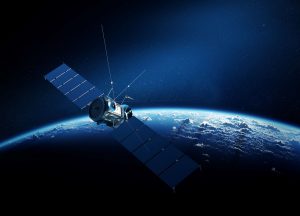Key Takeaways
- Deep space optical communication (DSOC) uses laser-based systems for high-bandwidth, interplanetary data transfer.
- NASA’s DSOC project achieved a 266 Mbps downlink from 19 million miles using photon-efficient modulation and precision optics.
- The system includes a dual-wavelength flight transceiver, ground-based multi-laser uplink, and photon-counting receiver at Palomar Observatory.
- Key challenges include beam stability, extreme sensitivity, and SWaP constraints.
- Avantier supports such missions with space-qualified optics, FSM-integrated modules, and design services for ultra-long-range free-space optical links.
Deep Space Optical Communications
Deep space optical communication (DSOC) leverages laser-based free-space transmission to enable high-bandwidth data exchange across interplanetary distances. Offering orders-of-magnitude improvement over traditional radio frequency (RF) systems in terms of data rate and aperture efficiency, DSOC represents a paradigm shift in spacecraft telemetry, remote sensing, and command uplinks.
At the forefront of this transformation is NASA’s Deep Space Optical Communication project, led by the Jet Propulsion Laboratory (JPL) in Pasadena, California. Its landmark demonstration aboard the Psyche spacecraft in 2023 achieved a downlink rate of 266 Mbps from a distance of 19 million miles using a near-infrared laser system. This marked the longest-distance optical video transmission to date. Follow-up tests in 2024 extended the link range to 140 million and 290 million miles, with data reception facilitated by the 5-meter Hale Telescope at Palomar Observatory, retrofitted with high-sensitivity detectors.
In this article, we examine the architecture, components, modulation schemes, and optical engineering challenges associated with deep space optical communications, with a particular focus on Avantier’s role in advancing enabling optical technologies.
Design and Architecture of the DSOC Project
The DSOC architecture centers on three critical subsystems: the Flight Laser Transceiver (FLT), the Ground Laser Transmitter (GLT), and the Ground Laser Receiver (GLR). Each subsystem incorporates advanced optics, precision alignment, and sophisticated modulation/detection protocols.
1. Flight Laser Transceiver (FLT)
The FLT payload incorporates a dual-channel optical system: a 1550 nm downlink transmit channel and a 1064 nm receive channel. The downlink employs pulse position modulation (PPM) to optimize photon efficiency under ultra-low received power conditions. A high-power, single-mode laser diode is coupled via SMF to a fast steering mirror (FSM), which executes real-time pointing corrections with sub-microradian angular resolution. The system’s ability to apply accurate point-ahead angles compensates for relative motion between the spacecraft and Earth during transmission.
The receive channel features a 256 x 256 µrad field-of-view (FOV) and an 8 x 8 µrad instantaneous FOV. To maintain signal fidelity, the transceiver is mounted on an Isolation and Pointing Assembly (IPA), mitigating platform-induced vibrations and enabling precision tracking.
2. Ground Laser Transmitter (GLT)
The GLT uplink system transmits an acquisition and synchronization beacon using eight coherently combined 1064 nm high-power lasers. This multi-aperture approach counteracts atmospheric scintillation, ensuring consistent beam profile and pointing accuracy. Adaptive optics are implemented at the transmitter aperture to pre-compensate for turbulence-induced phase distortions.
3. Ground Laser Receiver (GLR)
Downlink signals are collected by the 200-inch Hale Telescope, modified to operate as a photon-counting receiver. The incoming signal is directed to a superconducting nanowire single-photon detector (SNSPD) array, with detection efficiencies exceeding 85% and dark count rates below 10 cps. Temporal photon arrival data is then processed using a gigahertz-rate digital signal processor (DSP) that handles demodulation, de-interleaving, synchronization, and forward error correction using low-density parity-check (LDPC) codes.
Engineering Challenges in Deep Space FSOC
The viability of DSOC is largely predicated on the ability to achieve diffraction-limited beam quality across astronomical distances while managing stringent SWaP (size, weight, and power) constraints. The design must also withstand radiation exposure, thermal cycling, and microgravity-induced misalignments.
Flight optics are typically constructed using low CTE materials such as Zerodur or fused silica, with dielectric coatings tailored to minimize chromatic aberration and back-reflections. Optical assemblies must pass rigorous environmental qualification tests, including vibration, thermal vacuum, and radiation survivability.
Photon Budget and Signal Analysis
The viability of DSOC is largely predicated on the ability to achieve diffraction-limited beam quality across astronomical distances while managing stringent SWaP (size, weight, and power) constraints. The design must also withstand radiation exposure, thermal cycling, and microgravity-induced misalignments.
Flight optics are typically constructed using low CTE materials such as Zerodur or fused silica, with dielectric coatings tailored to minimize chromatic aberration and back-reflections. Optical assemblies must pass rigorous environmental qualification tests, including vibration, thermal vacuum, and radiation survivability.

Optics for Deep Space Communication Systems
Avantier provides optical subsystems and custom components for both ground and flight FSOC platforms. Our capabilities include:
- High-power laser collimators with minimal wavefront error.
- Thermally stable beam steering modules with embedded FSMs.
- Space-qualified lens assemblies with athermalized mounts.
- Aspheric and freeform optics for minimized mass and optimized packaging.
We also offer simulation services for link budget estimation, optical path analysis, and optomechanical stress testing.
Conclusion
Deep space optical communications represent a leap forward in how humanity connects with spacecraft beyond Earth orbit. The integration of advanced photonic components, adaptive optics, and photon-counting detection systems opens new frontiers for data-rich missions to Mars, asteroids, and beyond. Avantier remains at the forefront of enabling this shift through precision-engineered optical technologies.
References
- Biswas et al. “Deep space optical communications technology demonstration,” Proc. SPIE 12877, Free-Space Laser Communications XXXVI, 1287706 (12 March 2024);
- McGovern, Anne. Deep-space camera sends farthest optical communications link yet. MIT Laboratory News, June 17 2024.
- Srinivasan et al., “The Deep Space Optical Communications project ground laser transmitter,” Proc. SPIE 12413, Free-Space Laser Communications XXXV, 124130Q (15 March 2023);






